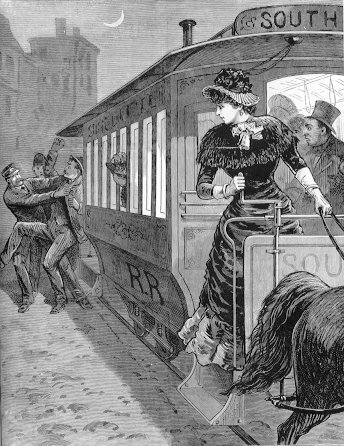Streetcars in Houston
Today, let's ride the Houston trolley. The University of Houston's College of Engineering presents this series about the machines that make our civilization run, and the people whose ingenuity created them.
You may not realize it, but Houston was once a national capital. In 1837, when Houston was only a year old, it served briefly as capital of the new Republic of Texas. We soon lost that role, but we kept up our rapid growth along Buffalo Bayou nevertheless.
During the Civil War, a rail spur on San Jacinto Street fell into disuse. After the war, someone realized this fifteen-block length of track could be used as a trolley line. For two years, a mule-drawn trolley took passengers up and down the street.
Steven Baron tells the history of trolley service here. It's the story of a wild west town hurriedly catching up with American industrialization. Our major western seaport, San Francisco, developed much faster. By the 1870s it had the first cable-driven public transportation. The cable car was created because mules and horses had trouble on San Francisco's steep hills.
But flat Houston was another matter. Two new horsecar systems fought it out with each other during the 1870s and '80s.
The German electrical engineer Werner Siemens meanwhile built a small electric rail system for the 1879 Berlin Industrial Exhibition. Edison, who created the first public electric-power system a few years later, took no interest in rail. But other American engineers worked on all kinds of electric railways -- battery-powered, third-rail-powered. Frank Sprague finally perfected the overhead trolley. Sprague had a good trolley system running in Richmond, Virginia, by 1888. It took only a year for most American cities to replace their horsecars with trolleys. The one in Portland, Oregon, ran all the way down to Salem, fifty miles south.
But Houston was still a frontier town, and we came late to electric trolleys. It took three years for trolleys to reach us. When they did, we became a trolley town for the next 23 years.
Then, one day in 1914, a primitive automobile pulled up to a trolley stop and offered to take the passengers for a nickel each. A year later, two hundred automobile jitneys were hauling passengers. The jitney evolved into the autobus. Trolleys began feeling the pressure after WW-I. The last one went out of business in 1940.
By then automobiles had made Houston into a very spread-out city. Despite a huge population, our population density was low. Public transportation in Houston needed more branches than use seemed to justify, so we gave ourselves over to the personal automobile.
That's why I think back to a childhood in St. Paul, Minnesota, where I rode trolleys until I left in 1946. After that, I never again got to ride a public trolley in America. I miss the lost smell of ozone formed by sparks as the trolley skipped over joints in the overhead line. When I came here, I could still see where the last trolleys had run on Heights Boulevard. But that's all they were - only tracks of a lost technological epoch. Today we find our population density rising very rapidly. And we might well look back with something more than nostalgia at those wonderful old electric trolleys.
I'm John Lienhard, at the University of Houston, where we're interested in the way inventive minds work.
(Theme music)
Baron, S. M., Houston Electric: The Street Railways of Houston, Texas. Lexington, KY: Steven M. Baron.
Trolley Museum, Oregon Electric Railway Historical Society, Official Guide to the Exhibition. Glenwood, OR: 1980
For a set of photos of a memorial to one of the important Houston trolley stops, click HERE.
